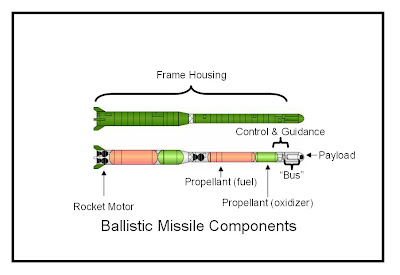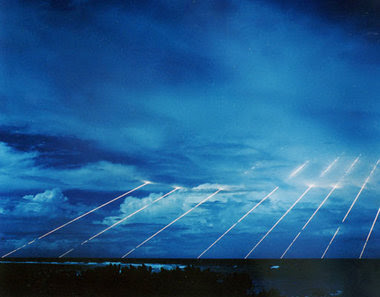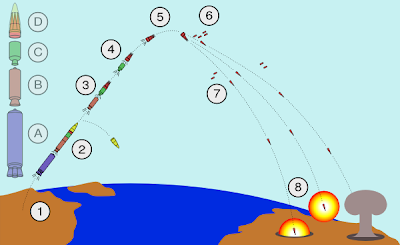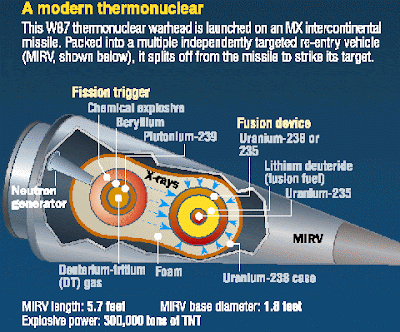Missile Defense 101 – ICBM Fundamentals
Definition – Ballistic Missile: A missile that is guided (powered) in the ascent portion of a high arch-trajectory and freely falling in the descent. (See illustration).
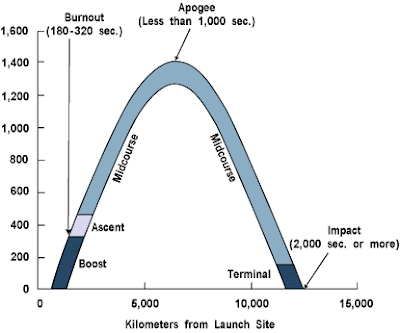
Ballistic missiles are categorized by ranges into the following classes of missile:
- Short-range: less than 1,000 km. Typically these are what have been called “battlefield” missiles and are represented by the likes of the SCUD-class, SS-21, Fateh 110 and Al Fatah.
- Medium-range: 1,000 – 3,000 km. Missiles in this class include the CSS-5, No Dong, Shahab-3 and Taepo Dong-1
- Intermediate-range: 3,000 – 5,500 km. Missiles here include the Agni II and III.
- Intercontinental-range: +5,500 km Only Russia, US, UK, France and China have demonstrated capabilities here with examples being the SS-27 (Russia), Minuteman III (US), Trident (UK & US – this is a sub-launched missile), M-5 (France – also an SLBM) and the CSS-4 (China). North Korea is developing a capability with the Taepo Dong 2.
- Boost phase: During this phase the missile is applying thrust to gain acceleration while establishing its trajectory downrange. During this phase, the fuel from all stages is exhausted. Typically, this phase lasts anywhere from 3-5 minutes endo-atmospheric and generates a highly visible plume of exhaust gases which is critical to initial detection and warning.
- Midcourse phase: This is the longest part of the flight – usually about 20-30 minutes for ICBMs and occurs outside of the atmosphere for ICBMs. IRBMs will see a portion of their midcourse flight exo-atmospheric, but SR-and MRBMs typically will remain endo-atmospheric, but skirt the edge of space at their apogee. This is also the time of flight that penetration aids and countermeasures are dispensed along with multiple warheads (if equipped).
- Terminal phase: Terminal phase is marked by re-entry into the atmosphere with exceptional energy being generated in free fall (up to 14,000 mph). Penetration aids and debris accompanying the warhead(s) are usually stripped away by the atmosphere at this point as well. This time frame usually lasts only 1-2 minutes.
- Frame housing: usually what is thought of as the missile’s airframe (minus the payload) it is made of aluminum or more recently, composites (fiberglass re-enforced plastics typically) for strength and light weight.
- Rocket motor or engine: These may be either solid- or liquid-fueled or a combination (liquid-fueled lower stages, solid fuel upper stage).
- Propellant: propellant includes both the fuel (e.g., liquid hydrogen, hydrazine) and an oxidizer like liquid oxygen or nitrogen tetroxide. There are actually three types of propellant, each with their own inherent advantages and disadvantages:
- Liquid: either-
- Cryogenic: must be kept extremely cold and fueled just prior to launch but provides a 40% higher impulse than other liquid variants;
- Hypergolic: liquid at room temperature and when combined, spontaneously combusts requiring no ignition source; or
- Monopropellant: provides the best power performance and re-start capability, but is highly unstable, exceptionally toxic and corrosive.
- Solid: Preferred for mobile systems as it may be pre-loaded for storage/transportation, but is vulnerable to cracking and has no shut-off/re-start capability;
- Hybrid: solid fuel/liquid oxidizer – provides a safe, storable capability as well as shut-off/restart, but is very expensive and technically demanding to produce.
- Control & Guidance systems: consists of a Flight Path Control System (determines flight path) and Attitude Control System (keeps missile on path). May be provided by:
- Inertial guidance: based on an inertial platform based on mechanical or laser ring gyros, predominately used in the boost phase;
- Celestial: using stars to align the missile on track – usually mid-course, may also be combined with GPS or GLONASS satellite navigation systems;
- Terminal: using onboard sensors (the Pershing II, for example, used terrain-matching digital radar in the terminal phase to achieve a CEP of less than 10 meters).
- Vehicle launch system (or BUS): the vehicle that carries and dispenses the warheads and penetration aids.
- Payload: the re-entry vehicle(s) which may be:
- Unitary (a single, non-separating warhead that remains attached to the body such as the Scud)
- Multiple Re-entry Vehicles (MRV): not independently targetable, used to ensure Pk by overwhelming a point defense with warheads in the expectation that some will get through terminal defenses
- Multiple Independently Targeted Re-Entry Vehicles (MIRVs) – individual RVs assigned targets independently along the flight path. Complicates defenses by increasing the defended area.
- Maneuverable Re-Entry Vehicle (MaRV): via either RV body shaping or use of deployable mini-aerodynamic fins, the MaRV permits terminal area maneuvering or flight path extension to offset defensive measures established on predicted re-entry paths.
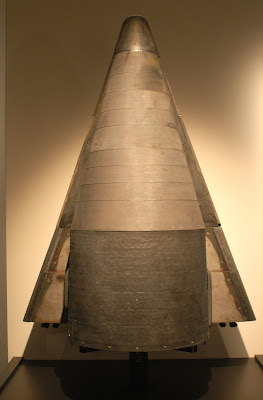
ASV-3 ASSET LIFTING BODY
- Note that the warheads themselves may be conventional or WMD (Chem/Bio/Nuclear).

Countermeasures/Penetration aides: In the early 1960s when it was increasingly becoming apparent that the US and Soviet Union were developing a nuclear endo- and exo-atmospheric ABM system, each side began working to develop penetration aides to counter detection, identification, classification and destruction of the RVs. One example of this may be seen in the Chevaline system jointly developed between the US and Britain and employed on British Polaris missiles in the 1960s. Penetration aids, just like their airborne cousins, include chaff, flares, replica decoys, metallized balloons, multi-layered RV shrouds and more. All are designed to overwhelm defensive systems by either jamming sensors or overwhelming with a mass of objects. An additional counter-measure is a technique called salvage fuzing, whereby a nuclear weapons effect (NWE) is generated when an offensive warhead self-detonates after being struck by a hit-to-kill interceptor. This creates the intense thermal and radiation effects associated with a nuclear detonation and can thereby also disrupt a defensive system. Because it is a highly complex and technical feature, it is also unlikely to be incorporated in a first-generation nuclear warhead/ICBM.



